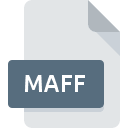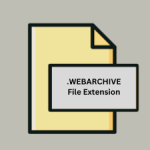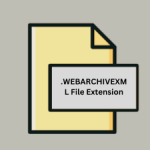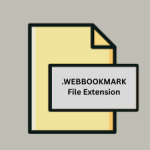.MAFF File Extension

What is an MAFF file?
The .MAFF file extension stands for Mozilla Archive Format File. It is a file format used primarily by Mozilla’s web browser to save and store a web page, along with its associated resources, such as images, stylesheets, and scripts, into a single compressed archive file.
This format aims to provide a way for users to archive web pages efficiently while preserving all of their essential elements, making offline access and future reference convenient.
More Information.
Initially, saving web pages was done through various methods, including saving the page as an HTML file with accompanying folders for resources or using the .MHT format.
These methods had limitations, such as larger file sizes and less efficient handling of resources. Mozilla introduced the .MAFF format to address these issues, offering a more compact and efficient way to store entire web pages.
The purpose of .MAFF files was to consolidate all page elements into a single file, making it easier for users to manage and archive web content without dealing with multiple files and folders.
Origin Of This File.
The .MAFF file format was introduced by Mozilla as part of its initiative to enhance user experience and web archiving capabilities.
Mozilla, known for its popular web browser Firefox, has always focused on improving web functionalities and user control.
The .MAFF format emerged as an evolution of earlier methods of saving web pages, such as the single-file .MHT (MIME HTML) format, but with improvements in compression and data management.
File Structure Technical Specification.
The .MAFF file is essentially a compressed archive that uses the ZIP format to bundle all the components of a web page. The structure of a .MAFF file is similar to that of other compressed archives, with several key elements:
- File Header: The file begins with a header that identifies it as a .MAFF archive. This header is used by software to recognize and correctly handle the file.
- Metadata: This section contains information about the archived web page, such as the URL, title, and encoding. Metadata is crucial for reconstructing the web page accurately when it is opened.
- Compressed Content: The main body of the .MAFF file contains the web page’s HTML, CSS, JavaScript, images, and other resources. These components are compressed using standard ZIP compression to reduce file size.
- Index: An index within the .MAFF file helps manage the various resources and their locations, ensuring that the web page displays correctly when the file is reopened.
The technical specifications of a .MAFF file ensure compatibility with various software tools that handle ZIP archives. This compatibility allows for easy extraction and viewing of the archived web content.
How to Convert the File?
Convert a .MAFF file, users typically need to extract its contents or convert it to a more widely accepted format. Here’s a general approach:
- Extract the Archive: Use a ZIP file extraction tool to extract the contents of the .MAFF file. Since .MAFF files are essentially ZIP archives, standard extraction tools like WinRAR, 7-Zip, or the built-in ZIP utility in many operating systems can handle this task.
- Re-save as HTML: Once extracted, locate the HTML file within the archive. This file represents the main content of the web page. You can re-save this HTML file along with its resources (images, CSS, JavaScript) to recreate the web page in a more conventional format.
- Convert Using Online Tools: Some online tools and software solutions can convert .MAFF files directly into other formats, such as PDF or HTML, depending on your needs.
Advantages And Disadvantages.
Advantages:
- Compact Storage: By compressing all web page elements into a single file, .MAFF files are typically smaller than storing HTML files with multiple resource folders. This makes them more efficient for storage and transfer.
- All-in-One Archive: The .MAFF format bundles all components of a web page into one file, eliminating the need to manage multiple files and folders.
- Preservation of Content: The format preserves the entire web page, including dynamic content and resources, providing a complete snapshot of the page as it appeared at the time of archiving.
- Easy to Use: Most web browsers that support the .MAFF format provide simple methods for saving and opening these files, making it user-friendly.
Disadvantages:
- Limited Support: The .MAFF format is specific to Mozilla and may not be widely supported by other web browsers or applications, which can limit its usability in diverse environments.
- Compression Overhead: While compression reduces file size, it can also introduce complexity in terms of opening and extracting files if the software does not fully support the format.
- Potential Data Loss: If a .MAFF file becomes corrupted or if the software used to create it does not handle compression correctly, there is a risk of losing some or all of the archived content.
How to Open MAFF?
Open In Windows
- Using Firefox: Firefox, the browser developed by Mozilla, has built-in support for opening .MAFF files. You can open these files directly within the browser to view the archived web page.
- Using Archive Software: For extraction, you can use tools like WinRAR or 7-Zip. Right-click on the .MAFF file, select “Extract here” or “Extract to,” and access the contents.
Open In Linux
- Using Firefox: Linux users can also use Firefox to open .MAFF files. As with other operating systems, drag and drop or use the “Open File” option.
- Using Archive Utilities: Linux systems typically have built-in support for ZIP files. Use command-line tools like
unzipor graphical tools like File Roller to extract .MAFF files.
Open In MAC
- Using Firefox: Similar to Windows, Firefox on macOS can open .MAFF files directly. Simply drag and drop the .MAFF file into the browser or use the “Open File” option.
- Using Archive Tools: Tools like The Unarchiver or Keka can be used to extract .MAFF files. Once extracted, you can view the HTML file using any web browser.













